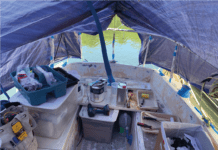The first issue of our 48th year of publication is as good a time as any to play curmudgeon. So let’s talk about the dream of sailing away—what it was, what has become of it, and what it will be like tomorrow.
Sailors today are truly lucky to live during a time when the act of pulling up stakes and sailing away is easier than ever. Sure, a global pandemic threw a big wrench in the works, but in terms of accessibility, the art of the watery escape has never been easier, or more affordable.
That last sentence is sure to draw some doubts, especially from those in the Northeast or West Coast where real estate developers are snapping up marinas, dressing them up (sometimes), raising fees, and chasing the little guys into backwater slips. But even now, in the midst of a surging interest in sailing unlike any we’ve seen in decades, you can buy a decent boat for about the price of a good used car. Sure, you might need to put some elbow grease into it, but there are enough how-to books and second-hand gear laying around that a refit doesn’t have to cost a fortune.
Even better, sailing away doesn’t mean you are foregoing a chance to make a living. There always have been sailors who have supported their wandering habit with work, but it usually meant plying a valued skill in a foreign port, or picking up whatever work was available. Today the same technologies that allow sailors to stay connected, tap into expert weather guidance, and navigate without worry of being lost also allows them to carry on with their day jobs from far corners of the earth.
But what happens when the dream becomes the job? It should be no surprise that the narrative thread that ran through the adventurous tales of early cruisers like John Guzzwell, Miles and Beryl Smeeton, Bernard Moitissier, Irving Johnson, and the Hiscocks would eventually enter popular culture via YouTube. After all, the cruising world is a place where experience is valued over possessions, community is cherished over self-centeredness, and the planet seems more precious with every passage. These are all notions I find my own boys embracing as they try to chart their own path through the world.
As the competition for “likes” intensifies, today’s sailing storytellers carry a burden of responsibility that the yarnspinners of the last century never did. The algorithms and immediate feedback loops of the digital age rapidly push entertainment to the extreme. Already, we’re seeing a growing trend of frightening storms, ship-board drama, and manufactured crisis saturating some YouTube sailing channels.
Should this trend continue, the prospects for sailors like me are deeply troubling. It is painful to even imagine a future in which a boring old salt with a flip phone, a one-eyed cat, and a passion for knots has no hope for a channel of his own. Or would he?











































I think social media sailing falls in to two camps: 1 is actual sailors going on actual voyages to interesting places. This is the minority but still forms a hot nucleus of content that I think we can all be proud of. The second camp is the eternal revolving door of the “cute young couple” who buy a boat and spend years rebuilding it. They never really seem to go much of anyplace and do nothing more than paint and grind. Often at the end of it, they sell the boat and either move ashore (so they can film themselves rebuilding a house) or they buy yet another boat (which they can rebuild.) If you look there is genuine hard core sailing content out there, and a need and desire for it.
The message “…in the Northeast or West Coast where real estate developers are snapping up marinas, dressing them up (sometimes), raising fees, and chasing the little guys into backwater slips.” hit a nerve. It made me wonder about the future of marinas. Some owned by cities, some privately owned, and those owned by clubs. I remember reading recently how a Florida boat owner was having difficulty finding a marina that would let him/her work on her own boat. Are there trends we should worry about or look out for?